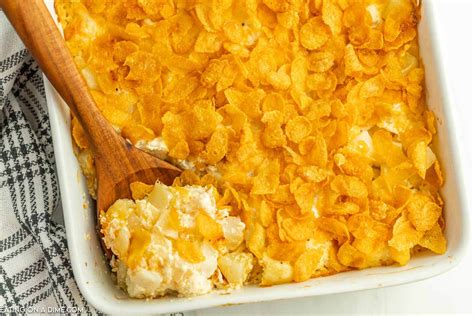
Funeral potatoes, a beloved comfort food staple at potlucks and post-funeral gatherings, are getting a flavor upgrade with a surprising ingredient: browned butter. According to food experts, incorporating browned butter into the classic cheesy potato casserole elevates the dish to a new level of richness and nutty complexity. This simple addition transforms a familiar favorite into a gourmet experience, promising a more nuanced and sophisticated taste.
Funeral potatoes, traditionally a creamy combination of shredded potatoes, cheese, sour cream, and a crunchy topping, are a comforting dish often associated with large gatherings, particularly in the Intermountain West. The dish’s enduring popularity stems from its ease of preparation, crowd-pleasing nature, and comforting flavors. Now, home cooks and chefs alike are exploring ways to enhance this classic recipe, with browned butter emerging as a game-changing addition.
The key to the browned butter technique lies in carefully melting butter over medium heat, allowing the milk solids to toast and caramelize. This process creates a nutty aroma and rich, complex flavor that infuses the entire casserole. Advocates of this method suggest incorporating browned butter into both the potato mixture and the crispy topping, maximizing its impact on the overall flavor profile.
“Browning the butter gives it this wonderful nutty depth,” says Sarah Jampel, recipe developer and food writer. “It just adds another layer of flavor that makes it really special.” The subtle nuances of the browned butter complement the creamy potatoes and cheesy components, resulting in a more balanced and satisfying dish.
This flavor elevation is not just about taste; it also speaks to the evolving culinary landscape. As home cooks become more adventurous and sophisticated, they seek to elevate even the most humble dishes with innovative techniques and ingredients. Browned butter, with its ease of preparation and significant flavor impact, is a perfect example of this trend.
While traditional funeral potato recipes rely on readily available ingredients like canned cream of mushroom soup or frozen hash browns, the browned butter upgrade doesn’t require any complicated substitutions. It simply adds an extra step to the butter-melting process, delivering a remarkable return on investment in terms of flavor.
The recipe variations for elevated funeral potatoes incorporating browned butter are numerous. Some cooks suggest using a combination of Gruyere and cheddar cheese for a sharper, more complex flavor. Others experiment with adding herbs like thyme or rosemary to the browned butter for an aromatic infusion. Some recipes suggest adding a splash of Worcestershire sauce for an umami boost. These additions allow for personalized variations that cater to individual preferences.
The resurgence of funeral potatoes, now with a gourmet twist, highlights the enduring appeal of comfort food and the ongoing quest to improve even the most beloved dishes. This simple yet impactful addition of browned butter promises to transform funeral potatoes from a simple casserole into a culinary delight, showcasing the power of a single ingredient to elevate a classic dish.
The History and Cultural Significance of Funeral Potatoes
Funeral potatoes, a dish deeply rooted in the culinary traditions of the Intermountain West, particularly within the Church of Jesus Christ of Latter-day Saints community, hold a significance that extends far beyond their simple ingredients. Their presence at potlucks, holiday gatherings, and, most notably, post-funeral receptions, has solidified their place as a symbol of comfort, community, and shared solace.
The exact origins of the dish are somewhat murky, with no single definitive recipe or inventor. However, its emergence can be traced back to the mid-20th century when convenience foods like frozen hash browns, canned soups, and processed cheeses became readily available. These ingredients allowed for quick and easy meal preparation, making funeral potatoes a practical choice for large gatherings where providing sustenance was a primary concern.
The name “funeral potatoes” itself is indicative of the dish’s cultural role. While the name might seem morbid to outsiders, it reflects the reality that funerals often involve a communal meal where family and friends gather to mourn and support one another. In these settings, funeral potatoes offer a comforting and familiar taste that provides a sense of normalcy and connection during a difficult time.
Beyond funerals, the dish has become a staple at other social events, including potlucks, family reunions, and holiday meals. Its versatility and crowd-pleasing nature make it a reliable option for feeding large groups. The simple, comforting flavors appeal to a wide range of palates, and the ease of preparation allows for minimal stress on the host.
The cultural significance of funeral potatoes extends beyond their practicality. The act of sharing food is a powerful way to express care and support, especially during times of grief. Funeral potatoes, with their creamy texture and comforting flavor, offer a tangible expression of sympathy and solidarity. The dish becomes a symbol of community, representing the collective effort to provide comfort and support to those who are grieving.
The dish also embodies the values of resourcefulness and community inherent in the regions where it is most popular. Utilizing readily available ingredients and sharing food with others reflect a tradition of mutual support and resilience. In a culture that often values simplicity and practicality, funeral potatoes represent a comforting and accessible dish that embodies these values.
The enduring popularity of funeral potatoes is a testament to their cultural significance. Despite evolving culinary trends and changing food preferences, the dish remains a beloved staple in many communities. Its ability to evoke feelings of comfort, nostalgia, and connection ensures its continued presence at gatherings for generations to come. The addition of browned butter only elevates this cultural icon, bringing new excitement to an old favorite.
Variations and Regional Differences
While the core ingredients of funeral potatoes remain relatively consistent across different recipes, variations and regional differences abound, reflecting the diverse culinary traditions and preferences of the communities where they are enjoyed. From subtle tweaks to significant modifications, these variations add a layer of complexity to the seemingly simple dish.
One of the most common variations involves the choice of cheese. While cheddar cheese is a ubiquitous ingredient in many funeral potato recipes, some cooks prefer to use a combination of cheeses for a more complex flavor profile. Gruyere, with its nutty and slightly sweet taste, is a popular addition, as is Monterey Jack, which offers a mild and creamy flavor. Other cheese options include Parmesan, for a salty and savory note, and pepper jack, for a touch of heat.
The type of potatoes used can also vary. While frozen hash browns are a convenient and widely used option, some cooks prefer to use freshly grated potatoes for a more rustic texture. Others opt for Yukon Gold potatoes, which offer a buttery flavor and creamy texture. Some recipes even call for mashed potatoes, resulting in an even smoother and richer casserole.
The creamy base of the casserole can also be modified to suit individual tastes. While canned cream of mushroom soup is a common ingredient, some cooks prefer to use a homemade cream sauce, made with butter, flour, and milk. Others add sour cream or Greek yogurt for a tangy flavor and creamy texture. Some recipes even incorporate cream cheese for an extra rich and decadent dish.
The topping, which provides a crucial textural contrast to the creamy potatoes, is another area where variations are common. Crushed cornflakes are a popular choice, offering a crispy and slightly sweet topping. Other options include crushed potato chips, crumbled Ritz crackers, or a mixture of breadcrumbs and melted butter. Some cooks add chopped pecans or walnuts for a nutty flavor and added crunch.
Regional differences in funeral potato recipes also reflect the culinary traditions and available ingredients of different areas. In some regions, for example, it is common to add diced ham or bacon to the casserole for a savory flavor. In others, green chiles or jalapenos are added for a touch of heat. Some regions even incorporate vegetables like onions, peppers, or mushrooms into the dish.
These variations and regional differences highlight the adaptability and enduring appeal of funeral potatoes. The dish can be customized to suit individual tastes and preferences, making it a versatile option for any occasion. Whether it’s a simple variation like adding a different type of cheese or a more significant modification like incorporating regional ingredients, these variations demonstrate the creativity and resourcefulness of home cooks. The new addition of browned butter is something that can be easily incorporated across all regional and personal recipe differences.
The Science Behind Browned Butter’s Enhanced Flavor
The transformative effect of browned butter on funeral potatoes, or any dish for that matter, is not simply a matter of culinary intuition; it is rooted in the complex chemical reactions that occur when butter is heated to a specific temperature. Understanding these reactions sheds light on why browned butter imparts such a distinctive and desirable flavor.
Butter, in its simplest form, is an emulsion of water, fat, and milk solids. When butter is heated, these components undergo a series of transformations that ultimately result in the rich, nutty, and complex flavor characteristic of browned butter.
The first stage of the process involves the melting of the butterfat. As the butter melts, the water content begins to evaporate, and the milk solids start to separate from the fat. These milk solids, which consist primarily of proteins and sugars, are the key to the flavor development in browned butter.
As the temperature continues to rise, the milk solids begin to brown. This browning is a result of two primary chemical reactions: the Maillard reaction and caramelization. The Maillard reaction is a non-enzymatic browning reaction that occurs between amino acids (the building blocks of proteins) and reducing sugars (such as lactose). This reaction produces hundreds of different flavor compounds, including aldehydes, ketones, and furans, which contribute to the characteristic aroma and flavor of browned butter.
Caramelization, on the other hand, is the browning of sugars that occurs when they are heated to a high temperature. In the case of browned butter, the lactose in the milk solids undergoes caramelization, producing sweet and slightly bitter flavor compounds.
The combination of the Maillard reaction and caramelization creates a complex and synergistic flavor profile. The aldehydes contribute to a nutty and roasted aroma, while the ketones add a buttery and creamy flavor. The furans contribute to a sweet and caramel-like flavor. Together, these compounds create a flavor that is far more complex and nuanced than that of plain melted butter.
The timing of the browning process is crucial. If the butter is heated for too long or at too high a temperature, the milk solids can burn, resulting in a bitter and acrid flavor. The ideal point is when the butter is a deep golden brown color and has a nutty aroma. At this stage, the Maillard reaction and caramelization have produced the optimal balance of flavor compounds.
The addition of browned butter to funeral potatoes enhances the dish in several ways. The nutty and roasted flavors of the browned butter complement the creamy potatoes and cheesy components, adding a layer of complexity and depth. The browned butter also contributes to a richer and more satisfying mouthfeel. The aromatic compounds in the browned butter enhance the overall sensory experience of the dish.
Tips and Tricks for Perfect Browned Butter
Browning butter, while seemingly simple, requires attention to detail to ensure optimal flavor and avoid burning. Here are some tips and tricks to help you achieve perfect browned butter every time:
-
Use a light-colored pan: A light-colored pan allows you to easily monitor the color of the butter as it browns, preventing it from burning. Stainless steel or light-colored enamel pans are ideal.
-
Use a saucepan with a heavy bottom: A heavy-bottomed saucepan will distribute heat more evenly, preventing hot spots that can cause the butter to burn.
-
Cut the butter into even-sized pieces: Cutting the butter into even-sized pieces ensures that it melts evenly and browns at the same rate.
-
Melt the butter over medium heat: Melting the butter over medium heat allows for a gradual browning process, giving you more control over the color and flavor.
-
Stir frequently: Stirring the butter frequently helps to prevent the milk solids from sticking to the bottom of the pan and burning.
-
Watch the color carefully: The butter will first melt and then begin to foam. As the foaming subsides, the milk solids will begin to brown. Watch the color carefully and remove the pan from the heat when the butter is a deep golden brown color and has a nutty aroma.
-
Trust your senses: Use your sense of smell and sight to determine when the butter is perfectly browned. The butter should have a nutty aroma and a deep golden brown color.
-
Don’t overcrowd the pan: If you are browning a large amount of butter, do it in batches to avoid overcrowding the pan. Overcrowding can lower the temperature and prevent the butter from browning properly.
-
Strain the browned butter (optional): If you prefer a smoother texture, you can strain the browned butter through a fine-mesh sieve to remove the browned milk solids. However, the milk solids contain a significant amount of flavor, so straining is not always necessary.
-
Use the browned butter immediately: Browned butter is best used immediately, as the flavor can diminish over time. If you need to store it, keep it in an airtight container in the refrigerator for up to a week. Reheat gently before using.
-
Infuse the browned butter: Experiment with infusing the browned butter with herbs, spices, or other flavorings. Add the flavorings to the butter as it is browning to infuse it with their flavor. Thyme, rosemary, garlic, and chili flakes are all popular choices.
-
Be patient: Browning butter takes time, so be patient and don’t rush the process. The longer you cook the butter, the more complex the flavor will become.
By following these tips and tricks, you can consistently achieve perfect browned butter and elevate your funeral potatoes, or any dish, to a new level of flavor.
Nutritional Considerations
While the addition of browned butter undeniably enhances the flavor of funeral potatoes, it’s essential to consider the nutritional implications of this modification. Browned butter, being essentially butter, contributes primarily fat to the dish.
Butter is a concentrated source of calories, with approximately 100 calories per tablespoon. The majority of these calories come from saturated fat, which has been linked to increased levels of LDL cholesterol (the “bad” cholesterol) and an increased risk of heart disease. However, some studies suggest that the impact of saturated fat on heart health may be more nuanced than previously thought, and that other factors, such as overall dietary patterns and lifestyle, also play a significant role.
In addition to saturated fat, butter also contains some vitamins and minerals, including vitamin A, vitamin D, vitamin E, and calcium. However, the amounts of these nutrients are relatively small, and butter is not considered a significant source of these nutrients.
The overall nutritional profile of funeral potatoes is also important to consider. The dish typically contains a significant amount of carbohydrates from the potatoes, as well as fat and sodium from the cheese, sour cream, and other ingredients.
Individuals with dietary restrictions or health concerns, such as high cholesterol, heart disease, or diabetes, should be mindful of the portion size and frequency with which they consume funeral potatoes, especially those made with browned butter. Making informed choices about ingredients and portion sizes can help to balance the enjoyment of this dish with the need to maintain a healthy diet.
Here are some ways to make funeral potatoes healthier:
- Use low-fat or non-fat sour cream: This can significantly reduce the fat content of the dish.
- Use reduced-fat cheese: Choose reduced-fat cheddar or other cheeses to lower the fat content.
- Increase the amount of vegetables: Add vegetables like onions, peppers, or mushrooms to increase the nutrient content and fiber.
- Use whole-wheat crackers or breadcrumbs for the topping: This will add fiber and nutrients.
- Control portion sizes: Be mindful of the amount of funeral potatoes you consume.
Frequently Asked Questions (FAQ)
-
What exactly are funeral potatoes? Funeral potatoes are a creamy potato casserole dish, often made with shredded or cubed potatoes, cheese, sour cream, and a crunchy topping, typically served at potlucks and gatherings, especially after funerals in the Intermountain West. They are known for their comforting and crowd-pleasing qualities.
-
Why are they called “funeral potatoes”? The name stems from the dish’s common appearance at post-funeral meals, where communities gather to support grieving families. The easy-to-make, comforting casserole is a practical and appreciated contribution to these gatherings.
-
What does browning butter do to the flavor? Browning butter intensifies its flavor by caramelizing the milk solids, creating a nutty, rich, and complex taste that adds depth and sophistication to dishes. This technique transforms ordinary butter into a flavorful ingredient.
-
Can I use any type of butter for browning? Yes, but unsalted butter is generally recommended because it allows you to control the salt content of the dish better. Be sure to watch it carefully as it browns, as the milk solids can burn if overheated.
-
How can I make funeral potatoes healthier without sacrificing flavor? You can use low-fat or non-fat sour cream, reduced-fat cheese, increase the amount of vegetables, and use whole-wheat crackers or breadcrumbs for the topping. These substitutions can significantly reduce the fat and increase the fiber content without compromising the taste.
Conclusion
The humble funeral potato, a dish steeped in tradition and community, has found new life with a simple yet transformative addition: browned butter. This culinary upgrade elevates the classic casserole from a comforting staple to a dish with a richer, more complex flavor profile.
The browning process unlocks a depth of nutty and caramelized notes that complement the creamy potatoes and cheesy components, creating a harmonious balance of flavors. The addition of browned butter is not just about taste; it reflects a broader trend of home cooks seeking to elevate even the most familiar dishes with innovative techniques and ingredients.
The enduring popularity of funeral potatoes speaks to their cultural significance and their ability to evoke feelings of comfort and nostalgia. By incorporating browned butter, home cooks can honor the tradition of this beloved dish while adding their own personal touch.
The key to success lies in understanding the science behind browned butter and mastering the technique. With careful attention and a few simple tips, anyone can achieve perfectly browned butter and unlock its transformative potential.
While the addition of browned butter does increase the fat content of the dish, there are ways to modify the recipe to make it healthier without sacrificing flavor. By using low-fat ingredients and increasing the amount of vegetables, home cooks can balance the enjoyment of this dish with the need to maintain a healthy diet.
Ultimately, the elevated funeral potato represents a celebration of tradition, innovation, and the power of simple ingredients to transform a dish. Whether served at a potluck, family gathering, or post-funeral reception, this updated classic is sure to impress and delight. The evolution of this dish demonstrates the enduring appeal of comfort food and the ongoing quest to improve even the most beloved recipes. It ensures that funeral potatoes will continue to be a cherished part of culinary traditions for generations to come, with a delicious and sophisticated twist. The browned butter modification solidifies its place as a versatile dish.









